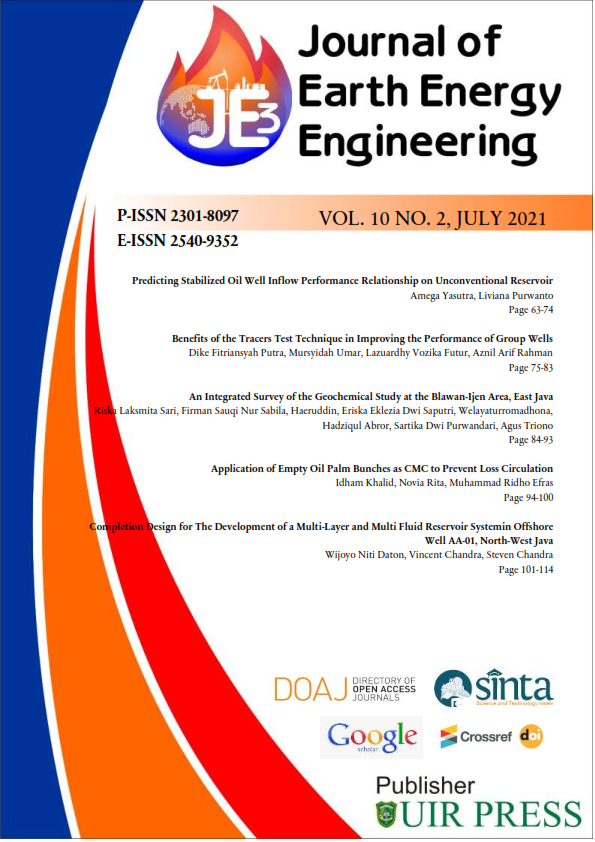An Integrated Survey of the Geochemical Study at the Blawan-Ijen Area, East Java
Abstract
Geothermal energy is a renewable alternative energy source. One of the analyses used to determine the characteristics of a geothermal field is water geochemical analysis. The target of this research is the Blawan-Ijen geothermal prospect area, Bondowoso. The geochemical analysis was carried out using AAS, Spectrophotometer and acid-base titration. This survey shows the characteristics of the geothermal system and geothermal fluid in the Blawan area, Ijen. From the chemical analysis of hot water, we found that the types of geothermal water fluids in the Blawan Ijen area vary. In samples BL1, BL2 and BL5 included in the type of Sulphate Water with the dominant elemental Sulphate (SO4) content is also known as Sulfuric Acid Water (Acid-Sulphate Water). Then for the BL4 sample included in the type of chloride water. This type of water is a type of geothermal fluid found in most areas with high-temperature systems. Areas with large-scale hot springs flowing with high Cl concentrations originate from deep reservoirs and indicate permeable zones in those areas. However, this area may not be located above the main upflow zone. There are several other possibilities, such as topographic influences, which can significantly impact hydrological control. The presence of chlorine gas can also identify high zones' permeable areas (e.g., faults, breccia eruptions or conduit). In contrast, BL3 samples are included in the Bicarbonate Water-type. The element HCO3 (bicarbonate) is the most dominant element (main anion) and contains CO2 gas from the chemical analysis results. HCO3 water is generally formed in marginal and near-surface areas in systems dominated by volcanic rocks, where CO2 gas and condensed water vapour into groundwater. The vapour condensation can either heat the groundwater or be heated by steam (steam heated) to form an HCO3 solution
Full text article
References
Badan Standarisasi Nasional. (1999). Metoda Estimasi Potensi Energi Panasbumi.
Delmelle, P., Bernard, A., Kusakabe, M., Fischer, T. P., & Takano, B. (2000). Geochemistry of the magmatic-hydrothermal system of Kawah Ijen volcano, East Java, Indonesia. Journal of Volcanology and Geothermal Research, 97(1–4), 31–53. https://doi.org/10.1016/S0377-0273(99)00158-4 DOI: https://doi.org/10.1016/S0377-0273(99)00158-4
Ellis, A. J. (1979). Chemical geothermometry in geothermal systems. Chemical Geology, 25(3), 219–226. https://doi.org/10.1016/0009-2541(79)90143-8 DOI: https://doi.org/10.1016/0009-2541(79)90143-8
Giggenbach, W. F. (1991). Chemical techniques in geothermal exploration. In Application of geochemistry in resources development (pp. 119–144). Exploration. New Zealand: Chemistry Division, DSIR, Private Bag.
Hutapea F. (2010). Eksplorasi Panas Bumi Dengan Metode Geofisika Dan Geokimia Pada Daerah Bonjol, Kabupaten Pasaman-Sumatra Barat. Institut Teknologi Bandung.
Kementrian ESDM. (2005). Blueprint Pengelolaan Energi Nasional 2005 – 2025.
Konstantinou, K. I., Perwita, C. A., Maryanto, S., Budianto, A., Hendrasto, M., & Surono. (2013). Maximal Lyapunov exponent variations of volcanic tremor recorded during explosive and effusive activity at Mt Semeru volcano, Indonesia. Nonlinear Processes in Geophysics, 20(6), 1137–1145. https://doi.org/10.5194/npg-20-1137-2013 DOI: https://doi.org/10.5194/npg-20-1137-2013
Maryanto, S., Dewi, C. N., Syahra, V., Rachmansyah, A., Foster, J. H., Nadhir, A., & Santoso, D. R. (2017). Magnetotelluric-geochemistry investigations of blawan geothermal field, East Java, Indonesia. Geosciences (Switzerland), 7(2), 41. https://doi.org/10.3390/geosciences7020041 DOI: https://doi.org/10.3390/geosciences7020041
Nasional, B. S. (1998). SNI Klasifikasi Potensi Energi Panas Bumi di Indonesia. In Badan Standardisasi Nasional (Vol. 20, Issue 02, pp. 85–92).
Simmons, S. (Geothermal I. the U. of A. (1998). Geochemistry lecture notes 1998 (Vol. 18). University of Auckland.
Suciningtyas, I. K. L. N., Maryanto, S., & Rachmansyah, A. (2013). Distribution of Hot Springs Blawan-Ijen Based on Geoelectrical Resistivity Data. Natural B, 2(2), 164–171. https://doi.org/10.21776/ub.natural-b.2013.002.02.11 DOI: https://doi.org/10.21776/ub.natural-b.2013.002.02.11
Sukhyar, R., Gurusinga, C., Widodo, S., Munandar, A., Dahlan, H., & Wahyuningsih, R. (2014). Potential and Development of Indonesia Geothermal Resources.
van Hinsberg, V., Berlo, K., van Bergen, M., & Williams-Jones, A. (2010). Extreme alteration by hyperacidic brines at Kawah Ijen volcano, East Java, Indonesia: I. Textural and mineralogical imprint. Journal of Volcanology and Geothermal Research, 198(1–2), 253–263. https://doi.org/10.1016/j.jvolgeores.2010.09.002 DOI: https://doi.org/10.1016/j.jvolgeores.2010.09.002
Zaennudin, A., Wahyudin, D., Surmayadi, M., & Kusdinar, E. (2012). Hazard assessment of Ijen volcanic eruption East Java. J. Environ. Geol. Hazard, 3, 109–132.
Authors
This is an open access journal which means that all content is freely available without charge to the user or his/her institution. The copyright in the text of individual articles (including research articles, opinion articles, and abstracts) is the property of their respective authors, subject to a Creative Commons CC-BY-SA licence granted to all others. JEEE allows the author(s) to hold the copyright without restrictions and allows the author to retain publishing rights without restrictions.




